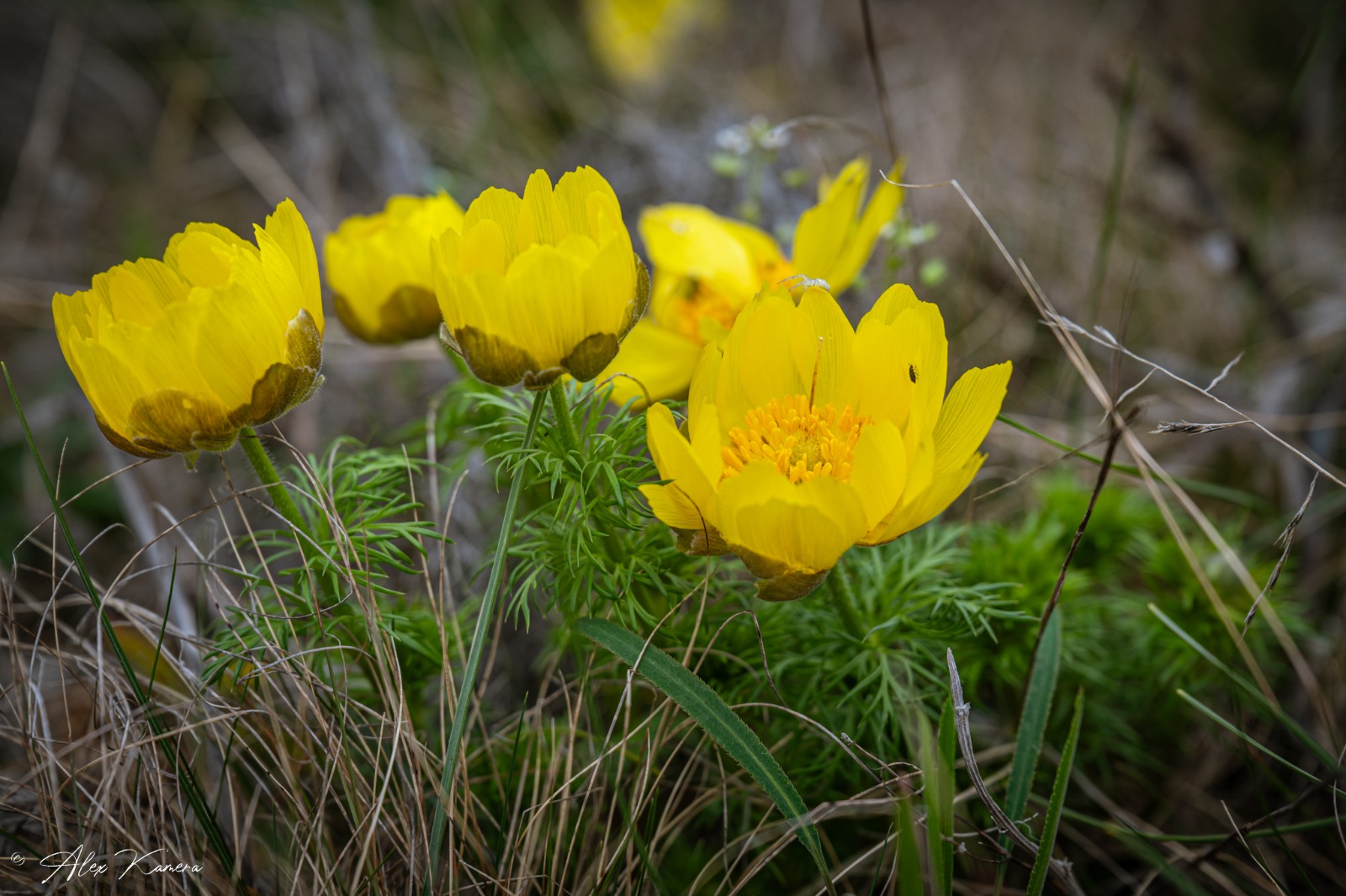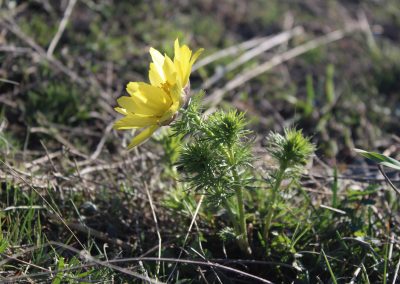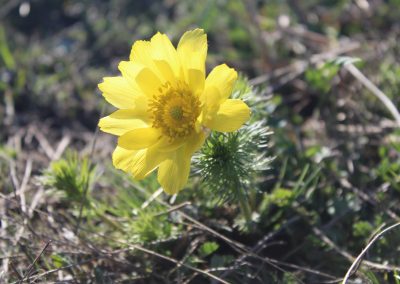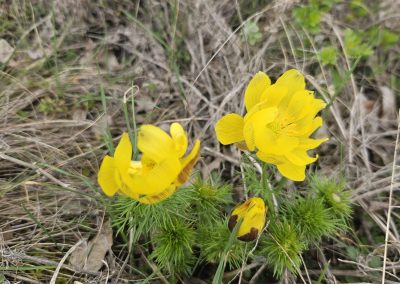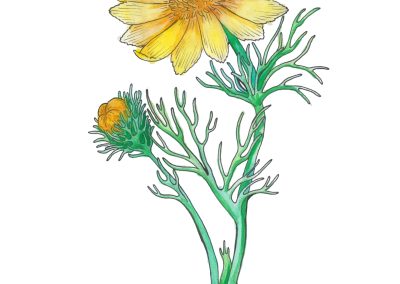Adonis Vernalis
Scientific description
Encrust: Angiospermatophyta (Magnoliophyta)
Class: Dicotyledonatae (Magnoliatae)
Subclass: Magnoliidae (Polycarpicae)
Order: Ranunculalae (Ranales)
Family: Ranunculaceae
Popular name: spring ruscus, sparkleweed, Easter flower, horse-weed
Description: is a herbaceous, perennial plant 10–40cm tall through a short, thickened, underground rhizome, from which grow aerial stems, some sterile and some floriferous, up to 40–45cm tall, with alternate, filiform leaves. The stem has solitary, actinomorphic flowers at the top, up to 8cm in diameter, sticky, yellow, with 5 sepals and numerous petals of 10 to 20, with several free carpels. The fruit of the ruscus is a polyaena. It flowers in early spring in sunny, dry meadows, pastures and even steep hillsides.
Propagation: seeds or pieces of rhizome.
Ecology: in our country it is widespread in the foothills and hills.
Use: it is a toxic plant, due to its glycosides (adonitoxin containing coumarin and vernadin), but at the same time medicinal, using the aerial parts, harvested when the plant is in full bloom. It also contains volatile oils, resins, choline and tannin. It is used as an infusion in hypertension, being a good cardiotonic herb, in neuro-vegetative disorders and even has diuretic properties.
Threats: It is a protected species declared a monument of nature, a honey species, toxic, decorative and medicinal.
Încrengătura: Angiospermatophyta (Magnoliophyta)
Clasa: Dicotyledonatae (Magnoliatae)
Subclasa: Magnoliidae (Polycarpicae)
Ordinul: Ranunculalaes (Ranales)
Familia: Ranunculaceae
Denumire populară: ruscuță primăvăratică, scânteiță, floarea Paștelui, buruiana - calului
Descrierea: este o plantă erbacee, perenă de 10–40cm înălțime printr-un rizom subteran, scurt și îngroșat, de pe care cresc tulpini aeriene, unele sterile și altele florifere, cu înălțimi de până la 40–45cm, cu frunze filiforme, alterne. Tulpina are în vârf flori solitare, actinomorfe, cu diametru de până la 8cm, lipicioase, galbene, cu 5 sepale și numeroase petale de la 10 până la 20, cu mai multe carpele libere. Fructul ruscuței este o poliachenă. Înflorește primăvara devreme, prin fânețe însorite, uscate, pășuni și chiar coaste abrupte.
Înmulțire: semințe sau bucăți de rizom.
Ecologie: la noi în țară este răspândită în zonele de podiș și deal.
Utilizare: este o plantă toxică, datorită glicozidelor (adonitoxină care conține cumarină și vernadină), dar în același timp medicinală, folosindu-se părțile aeriene, recoltate când planta este în plină floare. Conține și uleiuri volatile, rezine, colină și tanin. Se folosește sub formă de infuzie în hipertensiune arterială, fiind o bună plantă cardiotonică, în tulburări neuro-vegetative și are chiar și proprietăți diuretice.
Pericol: Este specie ocrotită declarată monument al naturii, specie meliferă, toxică, decorativă și medicinală.
Συνομοταξία: (Magnoliophyta)
Τάξη: (Magnoliatae)
Υποκατηγορία: Magnoliidae (Polycarpicae)
Τάξη: Ranunculalae (Ranales)
Οικογένεια: Ranunculaceae
Δημοφιλής ονομασία: spring ruscus, sparkleweed, Easter flower, horse-weed
Περιγραφή: Είναι ποώδες, πολυετές φυτό ύψους 10–40 εκατοστών μέσω ενός κοντού, παχυσμένου, υπόγειου ριζώματος, από το οποίο αναπτύσσονται εναέριοι βλαστοί, μερικοί στείροι και μερικοί ανθοφόροι, ύψους έως 40–45 εκατοστών, με εναλλασσόμενα, νηματοειδή φύλλα. Ο βλαστός έχει μοναχικά, ακτινόμορφα άνθη στην κορυφή, διαμέτρου έως 8cm, κολλώδη, κίτρινα, με 5 σέπαλα και πολλά πέταλα από 10 έως 20, με πολλά ελεύθερα καρπέλια. Ο καρπός του είναι πολυετής. Ανθίζει νωρίς την άνοιξη σε ηλιόλουστα, ξηρά λιβάδια, βοσκοτόπια, ακόμη και σε απότομες πλαγιές λόφων.
Πολλαπλασιασμός: σπόροι ή κομμάτια ριζώματος.
Οικολογία: στη χώρα μας είναι ευρέως διαδεδομένο στους πρόποδες και τους λόφους.
Χρήση: είναι ένα τοξικό φυτό, λόγω των γλυκοζιτών του (αδονιτοξίνη που περιέχει κουμαρίνη και βερναδίνη), αλλά ταυτόχρονα και φαρμακευτικό, χρησιμοποιώντας τα εναέρια μέρη, που συλλέγονται όταν το φυτό βρίσκεται σε πλήρη άνθηση. Περιέχει επίσης πτητικά έλαια, ρητίνες, χολίνη και τανίνη. Χρησιμοποιείται ως έγχυμα στην υπέρταση, όντας ένα καλό καρδιοτονωτικό βότανο, σε νευροβελτιωτικές διαταραχές και έχει ακόμη και διουρητικές ιδιότητες.
Απειλές: Είναι προστατευόμενο είδος που έχει ανακηρυχθεί μνημείο της φύσης, είδος μελιού, τοξικό, διακοσμητικό και φαρμακευτικό.
Famille: Angiospermatophyta (Magnoliophyta)
Classe: Dicotylédones (Magnoliatae)
Sous-classe: Magnoliidae (Polycarpicae)
Ordre: Ranunculales (Ranales)
Famille: Ranunculaceae
Nom populaire: ruscus de printemps, herbe aux étincelles, fleur de Pâques, chiendent
Description: c'est une plante herbacée, vivace, de 10 à 40 cm de haut, à partir d'un rhizome souterrain court et épais, d'où partent des tiges aériennes, certaines stériles et d'autres florifères, jusqu'à 40–45 cm de haut, avec des feuilles alternes et filiformes. La tige porte au sommet des fleurs solitaires, actinomorphes, jusqu'à 8 cm de diamètre, collantes, jaunes, avec 5 sépales et 10–20 pétales, avec plusieurs carpelles libres. Le fruit du ruscus est un polyaena. Il fleurit au début du printemps dans les prairies ensoleillées et sèches, les pâturages et même sur les pentes abruptes.
Multiplication: graines ou morceaux de rhizome.
Écologie: dans notre pays, elle est répandue dans les contreforts et les collines.
Utilisation: c'est une plante toxique, en raison de ses glycosides (adonitoxine contenant de la coumarine et de la vernadine), mais en même temps médicinale, en utilisant les parties aériennes, récoltées lorsque la plante est en pleine floraison. Elle contient également des huiles volatiles, des résines, de la choline et du tanin. Elle est utilisée en infusion dans l'hypertension, étant une bonne plante cardiotonique, dans les troubles neurovégétatifs et possède même des propriétés diurétiques.
Menaces: C'est une espèce protégée déclarée monument naturel, une espèce mellifère, toxique, décorative et médicinale.
Creative writing inspired by Adonis Vernalis
Written by Didina Cosma
Eternal Beauty
Adonis Vernalis is a flower that blooms around Easter. It is said that when Jesus was crucified, his blood dripped onto the baskets full of eggs, which turned red, and from his eyes, streams of bitter tears fell on the ground, and turned into yellow flowers with petals as bright as the sun.
Another legend says that in Greece, lived the beautiful Adonis, son of King Theias of Assyria and Smyrna, the king's daughter, who was enchanted by Aphrodite to fall in love with her father. She was turned into a myrtle tree, which Aphrodite split open, and took Adonis out of it. As soon as Aphrodite saw Adonis, she felt overwhelmed by a strong passion for him, and asked Persephone to hide him in a magic chest, in order to avoid the wrath and envy of the gods. Zeus discovered him and decided that a third of the time he would hunt in the woods, a third would be spent with Persephone and a third with Aphrodite. But Adonis, pierced with an arrow of love by the sturdy god, Cupid, cared for Aphrodite dearly: he always kept her company, offered her colourful flowers, wove her wreaths of flowers which he would crown her with, making Persephone extremely jealous. Ares, the god of war, became even angrier, when he saw the wreath of flowers on Aphrodite’s head, and so, he threw it around, stamped bitterly on the beautiful flowers and called Adonis to battle.
They fought for a whole day, and suddenly, Ares, the god, turned into a mad bull that impaled Adonis with its horns, and in the evening, defeated by the bull’s horns, he gave his last breath. On hearing of what had happened, Aphrodite, ran her heart out, took Adonis’s beautiful body and anointed it with oils, in the hope of reviving it, but to no avail. Seeing how beautiful he was, even dead, she wrapped him in her veils of fine silk and buried him in a secret glade, where no malicious and envious god could ever find him.
The next day, when she went to his grave, the goddess saw some fir-looking flowers, yellow, with bright petals. The goddess picked them with love, and wove herself a wreath, thinking about the wreaths he had made for her… and named the flowers "Adonis Vernalis," for they were like him: beautiful, bright and slender.
Didina Cosma
Frumusețe eternă
Adonis Vernalis este o floare ce-nflorește în preajma Paștelui. Se spune că atunci când era răstignit, lui Iisus îi curgea sângele pe coșurile pline cu ouă, care se înroșeau, iar din ochi, îi curgeau șiroaie de lacrimi amare și atunci când cădeau pe pământ, se preschimbau în niște flori galbene, cu petale strălucitoare ca soarele.
O altă legendă spune că în Grecia trăia frumosul Adonis, fiul regelui Theias din Asiria și al Smyrnei, fiica acelui rege, fermecată de Afrodita să se îndrăgostească de tatăl său. Aceasta a fost transformată într-un arbore de smirnă, pe care Afrodita l-a despicat și a scos pe Adonis. De cum l-a văzut, a și fost cuprinsă de o puternică pasiune pentru el și a rugat-o pe Persefona să-l ascundă într-un cufăr fermecat, ca să îl ferească de mânia și invidia zeilor. Zeus l-a găsit și a hotărât ca o treime din timp să vâneze prin păduri, o treime să stea cu Persefona și o treime cu Afrodita. Dar Adonis, străpuns cu o săgeată a iubirii, de către șturlubaticul zeu Cupidon, o iubea nespus de mult pe Afrodita: îi ținea mereu calea, îi dăruia flori multicolore, îi împletea câte o cunună și i-o așeza pe cap, făcându-i în ciudă Persefonei. Și mai multă ciudă i-a provocat lui Ares, zeu al războiului, care, văzând cununa de flori de pe capul Afroditei, s-a înfuriat, a azvârlit-o cât colo, a călcat-o în picioare și l-a chemat la luptă pe Adonis.
S-au luptat o zi întreagă și deodată, zeul Ares s-a transformat într-un taur furios ce l-a împuns cu coarnele pe Adonis. Spre seară, răpus de coarnele taurului, Adonis își dădu ultima suflare. Aflând despre cele întâmplate, Afrodita, alergă într-un suflet, luă trupul superb al lui Adonis și îl unse cu uleiuri în speranța că îi va putea reda viața, dar nu reuși. Văzând cât de frumos este, chiar și mort, îl înfășură în voalurile ei de mătase fină și îl îngropă într-o poieniță secretă, unde să nu îl poată descoperi niciun zeu răutăcios și plin de invidie.
A doua zi, când se duse la mormântul lui, zeița văzu niște flori cu aspect de brăduț, galbene, cu petale strălucitoare. Zeița le culese cu drag, își împleti o cunună amintindu-și de coronițele de flori culese de el… și le numi „Adonis Vernalis”, căci erau asemeni lui: frumoase, vioaie și zvelte.
Αιώνια Ομορφιά
Ο Άδωνις Βερνάλης είναι ένα λουλούδι που ανθίζει γύρω στο Πάσχα. Λέγεται ότι όταν ο Ιησούς σταυρώθηκε, το αίμα του έσταξε πάνω στα καλάθια γεμάτα με αυγά, τα οποία έγιναν κόκκινα, και από τα μάτια του, ρυάκια πικρών δακρύων έπεσαν στο έδαφος και μετατράπηκαν σε κίτρινα λουλούδια με πέταλα τόσο λαμπερά όσο ο ήλιος.
Ένας άλλος μύθος λέει ότι στην Ελλάδα ζούσε ο όμορφος Άδωνις, γιος του βασιλιά Θεία της Ασσυρίας και η Σμύρνα, η κόρη του βασιλιά, ο οποία μαγεύτηκε από την Αφροδίτη και ερωτεύτηκε τον πατέρα της. Μετατράπηκε σε μυρτιά, την οποία η Αφροδίτη άνοιξε και έβγαλε τον Άδωνι από μέσα της. Μόλις η Αφροδίτη είδε τον Άδωνι, ένιωσε να την κατακλύζει ένα έντονο πάθος γι' αυτόν και ζήτησε από την Περσεφόνη να τον κρύψει σε ένα μαγικό σεντούκι, για να αποφύγει την οργή και τον φθόνο των θεών. Ο Δίας τον ανακάλυψε και αποφάσισε ότι το ένα τρίτο του χρόνου θα κυνηγούσε στο δάσος, το ένα τρίτο θα το περνούσε με την Περσεφόνη και το άλλο με την Αφροδίτη. Αλλά ο Άδωνις, τρυπημένος με ένα βέλος αγάπης από τον στιβαρό θεό Έρωτα, φρόντιζε πολύ την Αφροδίτη: της έκανε πάντα παρέα, της πρόσφερε πολύχρωμα λουλούδια, της έπλεκε στεφάνια από λουλούδια, κάνοντας την Περσεφόνη εξαιρετικά ζηλιάρα. Ο Άρης, ο θεός του πολέμου, θύμωσε ακόμα περισσότερο όταν είδε το στεφάνι από λουλούδια στο κεφάλι της Αφροδίτης, το πέταξε τριγύρω, πάτησε πικρά τα όμορφα λουλούδια και κάλεσε τον Άδωνι σε μάχη.
Πολέμησαν για μια ολόκληρη μέρα και ξαφνικά, ο θεός Άρης μετατράπηκε σε τρελό ταύρο που κάρφωσε τον Άδωνη με τα κέρατά του, και το βράδυ, νικημένος από τα κέρατα του ταύρου, άφησε την τελευταία του πνοή. Μόλις άκουσε τι είχε συμβεί, η Αφροδίτη πήρε το όμορφο σώμα του Άδωνη και το άλειψε με έλαια, με την ελπίδα να το αναβιώσει, αλλά μάταια. Βλέποντας πόσο όμορφος ήταν, ακόμα και νεκρός, τον τύλιξε με τα πέπλα της από λεπτό μετάξι και τον έθαψε σε ένα μυστικό ξέφωτο, όπου κανένας κακόβουλος και ζηλιάρης θεός δεν θα μπορούσε ποτέ να τον βρει.
Την επόμενη μέρα, όταν πήγε στον τάφο του, η θεά είδε μερικά λουλούδια που έμοιαζαν με έλατο, κίτρινα, με φωτεινά πέταλα. Η θεά τα μάζεψε με αγάπη και έπλεξε ένα στεφάνι, σκεπτόμενη τα στεφάνια που της είχε φτιάξει… και ονόμασε τα λουλούδια «Άδωνις Βερνάλης», γιατί ήταν σαν κι αυτόν: όμορφα, φωτεινά και λεπτά.
Beauté éternelle
Adonis Vernalis est une fleur qui fleurit à Pâques. On raconte que lorsque Jésus fut crucifié, son sang coula sur les paniers remplis d'œufs, qui devinrent rouges, et que de ses yeux tombèrent sur le sol des torrents de larmes amères qui se transformèrent en fleurs jaunes aux pétales aussi brillants que le soleil.
Une autre légende raconte qu'en Grèce vivait le bel Adonis, fils du roi Théias d'Assyrie et de Smyrne, la fille du roi, qui fut enchantée par Aphrodite et tomba amoureuse de son père. Elle fut transformée en myrte, qu'Aphrodite fendit pour en faire sortir Adonis. Dès qu'Aphrodite vit Adonis, elle se sentit envahie par une forte passion pour lui et demanda à Perséphone de le cacher dans un coffre magique, afin d'éviter la colère et la jalousie des dieux. Zeus le découvrit et décida qu'il chasserait un tiers du temps dans les bois, qu'il passerait un tiers avec Perséphone et un tiers avec Aphrodite. Mais Adonis, transpercé d'une flèche d'amour par le robuste dieu Cupidon, tient beaucoup à Aphrodite : il lui tient toujours compagnie, lui offre des fleurs colorées, lui tresse des couronnes de fleurs dont il la couronne, ce qui rend Perséphone extrêmement jalouse. Arès, le dieu de la guerre, devint encore plus furieux lorsqu'il vit la couronne de fleurs sur la tête d'Aphrodite, et il la jeta, piétina amèrement les belles fleurs et appela Adonis au combat.
Ils se battirent pendant toute une journée, et soudain, le dieu Arès se transforma en un taureau fou qui empala Adonis avec ses cornes, et le soir, vaincu par les cornes du taureau, il rendit son dernier souffle. En apprenant ce qui s'était passé, Aphrodite prit le beau corps d'Adonis et l'oignit d'huiles, dans l'espoir de le faire revivre, mais en vain. Voyant combien il était beau, même mort, elle l'enveloppa dans ses voiles de soie fine et l'enterra dans une clairière secrète, où aucun dieu malveillant et envieux ne pourrait jamais le trouver.
Le lendemain, alors qu'elle se rendait sur sa tombe, la déesse aperçut des fleurs de sapin, jaunes, aux pétales éclatants. La déesse les cueillit avec amour et se tressa une couronne en pensant aux couronnes qu'il avait faites pour elle... et nomma les fleurs « Adonis Vernalis », car elles lui ressemblaient : belles, brillantes et élancées.


